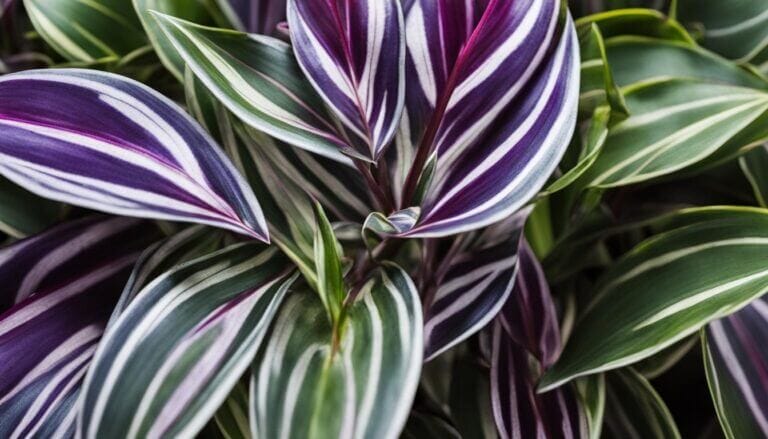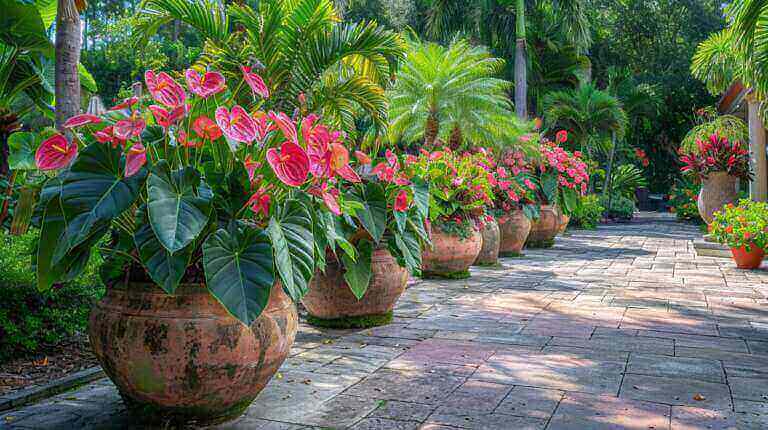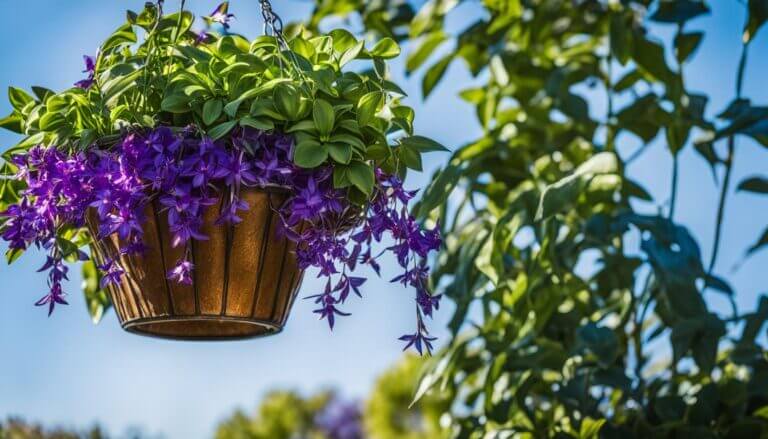Dumb Cane Dieffenbachia Plant Care Guide: Watering, Light, Soil Needs, and More
As an indoor houseplant, the dumb cane plant, also known as dieffenbachia plant, is a popular choice for adding a touch of tropical beauty to your home. With its pointed, ovate leaves in various shades of green, cream, and white, this plant can thrive with proper care and attention. In this comprehensive guide, I will provide you with valuable insights on how to care for your dumb cane plant, covering essential aspects such as watering, light requirements, soil needs, and more.
Key Takeaways:
- Understanding the watering needs of your dumb cane plant is crucial for preventing both overwatering and underwatering.
- Proper lighting conditions, including bright indirect light and avoiding direct sunlight, are essential for the growth and health of your dumb cane plant.
- The ideal soil for dumb cane plants is well-draining and rich in organic matter, promoting healthy root development.
- Regular fertilization and pruning are essential for maintaining the vitality and appearance of your dumb cane plant.
- Keep in mind that dieffenbachia plants can be toxic if ingested, so it’s important to place them out of reach of pets and children.
Dumb Cane Plant Overview
Dieffenbachia, commonly known as Dumb Cane Plant, is a popular houseplant that is loved for its lush foliage and easy care requirements. Native to Central and South America, this tropical beauty adds a touch of the tropics to indoor settings.
Dumb Cane Plant Description and Characteristics
Dumb Cane plants are known for their large, broad leaves that have distinct patterns and variegation. The leaves are typically green with white or yellow markings, but there are also solid green varieties available. These plants can grow up to 6 feet tall and make a striking focal point in any room.
One of the unique characteristics of Dumb Cane plants is their ability to produce sap that contains calcium oxalate crystals. These crystals can cause skin irritation and discomfort if ingested, which is why it is important to keep these plants away from curious pets and children.
Common Varieties of Dumb Cane Plant
There are several varieties of Dumb Cane plants available, each offering its own unique features.
- Dieffenbachia ‘Exotica’: This variety has vibrant green leaves with white veins running through them, creating a stunning contrast.
- Dieffenbachia ‘Camille’: With its creamy yellow and green variegated leaves, this variety adds a pop of color to any space.
- Dieffenbachia ‘Tropic Snow’: This variety features leaves with a mix of green, white, and gray markings, giving it a frosty appearance.
- Dieffenbachia ‘Sterling’: With its silver-gray leaves and green veins, this variety adds a touch of elegance to any room.
Choosing the right variety of Dumb Cane plant can enhance the visual appeal of your indoor space and create a stunning focal point. Make sure to select a variety that suits your aesthetic preferences and fits well with the overall decor.
Light Requirements
Optimal Light Conditions for Dumb Cane Plant
Dumb cane plants grow best in bright, filtered light during the majority of the year (spring, summer, and fall) and tolerate full sunlight in the winter months. It is essential to provide them with adequate light to maintain their vibrant foliage and healthy growth.
Indoor Placement and Sunlight Exposure
When choosing a spot for your dumb cane plant indoors, consider its light requirements. Place it in a location where it can receive indirect light or low light throughout the day. Avoid placing it in direct sunlight, as this can scorch its leaves. However, during the winter months when sunlight is limited, you can move your dumb cane plant closer to a window or provide it with some direct sunlight for a few hours each day.
If you notice that your dumb cane plant’s leaves are turning yellow or brown, it may be an indication that it is receiving too much sunlight. In such cases, move the plant to a location with lower light intensity.
It is important to note that dumb cane plants are adaptable to different light conditions, but they thrive best in bright, indirect light. So, finding the right balance of light exposure will help ensure the plant’s overall health and longevity.
Consider placing your dumb cane plant near a north- or east-facing window, or use sheer curtains or blinds to filter the sunlight. If you notice that the plant is leaning towards the light source, rotate it periodically to promote even growth.
Watering Guide
Proper watering is essential for the health and vitality of your Dumb Cane plant. Here are some guidelines to follow when watering your plant:
Watering Frequency and Method for Dumb Cane Plant
Dumb Cane plants prefer evenly moist soil but not soggy conditions. The frequency of watering will depend on various factors such as the size of the plant, the light and temperature conditions, and the type of pot and soil used. As a general rule, it is best to water your Dumb Cane plant when the top inch of soil feels dry to the touch. Feel the soil with your finger, and if it is dry, it is time to water.
When watering, thoroughly saturate the soil until you see water pooling in the saucer. This ensures that the roots receive adequate moisture. Avoid overwatering, as this can lead to root rot and other issues. Remember, it is always better to underwater than to overwater your plant.
Signs of Overwatering and Underwatering
Droopy leaves are often caused by underwatering. Feel the soil of your plant; when the surface is dry to the touch, your plant is ready for watering. Overwatering can cause the leaves of your Dumb Cane plant to turn yellow and eventually fall off. If you notice these signs, it is crucial to adjust your watering routine accordingly.
To prevent overwatering, make sure your pot has proper drainage holes to allow excess water to escape. If your pot does not have drainage holes, be more precise in your watering to avoid waterlogging the roots.
Soil Needs
Ideal Soil Type and Composition for Dumb Cane Plant
The ideal soil type for the Dumb Cane plant is a well-draining potting mix. It is important to ensure that the soil does not become waterlogged, as this can lead to root rot and other issues. The soil should also be moist, but not overly wet.
To create the perfect soil composition for your Dumb Cane plant, you can make your own soil mix or purchase a pre-made potting mix. If you choose to make your own, a good recipe to follow is one part humus, one part garden soil, and one part perlite or coarse sand. This mixture provides the necessary nutrients and drainage for the plant to thrive.
Potting Mix and Soil Amendments
When potting your Dumb Cane plant, it is important to use a potting mix that is specifically formulated for indoor plants. This will provide the necessary nutrients and drainage for the plant to grow and thrive.
If you prefer to amend your soil, you can add organic matter such as compost or peat moss to improve moisture retention and nutrient content. This can help create a more fertile and well-balanced soil environment for your Dumb Cane plant.
It is also important to note that Dumb Cane plants prefer slightly acidic soil. If your soil pH is too high, you can add a pinch of lime to help balance it out. However, be cautious not to add too much lime, as it can harm the plant.
Temperature and Humidity
Preferred Temperature Range for Dumb Cane Plant
The Dumb Cane plant thrives best in temperatures between 65°F and 75°F (18°C to 24°C). It is important to keep the plant away from drafts and sudden temperature changes, as this can cause stress and damage to the leaves. Avoid placing the plant near air conditioning units or heating vents, as they can create fluctuations in temperature.
During winter, it is crucial to keep the Dumb Cane plant in a warm and humid environment. If the temperature drops below 60°F (15°C), it can result in leaf discoloration and stunted growth. To maintain the desired temperature range, consider using a space heater or insulation to protect the plant.
Humidity Levels and Plant Care
The Dumb Cane plant thrives in high humidity levels, preferably between 50% and 60%. If the air is too dry, the plant may develop brown leaf tips and edges. To increase humidity around the plant, you can use a humidifier or place a tray filled with water near the plant, ensuring that the water does not touch the bottom of the pot.
Misting the leaves with water also helps to mimic the plant’s native tropical environment and provides additional moisture. However, avoid misting too frequently, as excessive water on the leaves can lead to fungal diseases.
Always keep the soil moist to make sure the plant is getting enough water, and watch out for leaf curling or drying – this is a sign of under watering. The leaves should feel rubbery and stiff. Bright conditions are great, but minimize the Dumb Cane’s exposure to direct sunlight, as this can damage the leaves.
Pruning and Propagation
Trimming and Pruning Dumb Cane Plant
Keeping your dumb cane plant well-maintained and looking its best is easy with regular trimming and pruning. While dumb cane does not require frequent pruning, it is beneficial to remove any shriveled, brown, yellow, or otherwise unattractive leaves. This helps to maintain the overall appearance of the plant and promote healthy growth.
When trimming, always use a clean pair of clippers to avoid introducing any diseases to the plant. Make sure to cut close to the base of the stem or leaf and remove any dead or dying foliage. Additionally, if your dumb cane plant becomes too tall or leggy, you can also trim the stems to encourage bushier growth.
Propagation Techniques for Expanding Your Collection
If you’re looking to expand your collection of dumb cane plants, propagation is a simple and reliable method. There are three common techniques for propagating dumb cane: through cuttings, division, or air layering.
- Cuttings: Take a healthy stem cutting from the mother plant, making sure it has at least two leaves. Dip the cut end in rooting hormone and plant it in a well-draining potting mix. Keep the soil consistently moist and place the cutting in indirect sunlight. After a few weeks, roots should develop, and you can gradually acclimate the new plant to its own pot.
- Division: Carefully remove the mother plant from its pot and gently separate the root ball into smaller sections. Each section should have a good amount of healthy roots and at least one stem. Plant these divisions in their own pots with fresh potting mix and water them thoroughly. Provide bright, indirect light and maintain proper watering to promote growth.
- Air Layering: This method involves creating a rooting chamber on a mature stem of the mother plant. To do this, make a small incision in the stem and insert a toothpick or plastic wrap to hold it open. Apply rooting hormone to the exposed section and wrap moist sphagnum moss around it. Cover the moss with plastic wrap and secure it in place. After a few months, roots should develop, and you can separate the new plant from the mother plant.
Dumb Cane Plant Care Guide: Watering, Light, Soil Needs, and More
Dumb cane plants, known for their beautiful foliage and air-purifying qualities, require specific care to thrive. Proper watering, lighting, and soil conditions are crucial for the health and well-being of these plants.
Watering
Watering is a key aspect of dumb cane plant care. These plants prefer consistently moist soil, but it should not be soggy or overwatered. It is important to water the plant deeply, allowing the water to penetrate the root zone. However, you should wait until the soil has dried out before watering again. To determine if the soil is dry, insert a finger into the soil up to the second knuckle. If it feels dry, it’s time to water. Avoid letting excess water accumulate in a dish or saucer, as it can lead to root rot. Empty any water remaining after irrigation.
Light
Dumb cane plants thrive in bright, indirect light. They should be placed in a location where they receive filtered sunlight or artificial light. Avoid exposing them to direct sunlight, as it can scorch the leaves. In areas with low light conditions, consider using artificial grow lights to provide adequate illumination for the plant.
Soil Needs
The soil for dumb cane plants should be well-draining and rich in organic matter. A mix of peat moss, perlite, and potting soil is ideal. This type of soil allows for proper drainage while also retaining enough moisture for the plant’s needs. It is important to avoid using heavy or compacted soil, as it can lead to waterlogged roots and other issues.
Humidity
Dumb cane plants thrive in high humidity environments. In dry climates, it can be challenging to provide adequate humidity. One solution is to place the plant’s container on a saucer filled with pebbles and water. As the water evaporates, it creates a humid microclimate around the plant. Another option is to use a room humidifier or mist the plant regularly to increase humidity levels.
FAQ
What is Dieffenbachia and how do I care for it?
Dieffenbachia, also known as the dumb cane, is a tropical plant that is easy to care for. It prefers bright light but can tolerate lower light conditions. Water the plant when the top inch of soil is dry and keep your plant in a location with high humidity.
How do I repot a Dieffenbachia plant?
To repot a Dieffenbachia plant, carefully remove it from its current pot and place it in a new pot with fresh soil. Be sure to give your plant plenty of water after repotting to help it settle into its new home.
What are some common problems with Dieffenbachia plants?
Some common problems with Dieffenbachia plants include yellow leaves, which can be a sign of overwatering, and lower leaves falling off, which is a normal part of the plant’s growth cycle.
What are some care tips for Dieffenbachia plants?
Some care tips for Dieffenbachia plants include providing bright, indirect light, watering when the top inch of soil is dry, and fertilizing during the growing season with a balanced houseplant fertilizer.
What are some different types of Dieffenbachia?
There are many types of Dieffenbachia, each with unique leaf patterns and sizes. Some popular varieties include Dieffenbachia Amoena, known for its large, vibrant leaves, and Dieffenbachia Compacta, which has a more compact growth habit.
Is Dieffenbachia safe for children and pets?
Dieffenbachia, also known as dumb cane, contains calcium oxalate crystals which can be irritating if ingested. Therefore, it’s best to keep this plant out of reach of children and pets.







